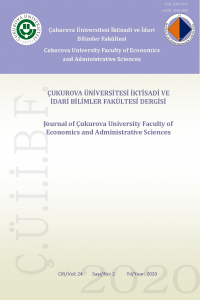Metasezgisel Yöntemler ve Uygulama Alanları
Metasezgisel Yöntemler, Eniyileme, Uygulama Alanları
Metaheuristic Methods and Their Application Areas
Metaheuristic Algorithms, Optimization, Application Areas,
___
- Birattari, M., Paquette, L., Stützle, T. ve Varrentrapp, K. (2001) “Classification of Metaheuristics and Design of Experiments for the Analysis of Components” Teknik Rapor, AIDA-01-05.
- Blum, C. ve Roli, A. (2003) “Metaheuristics in Combinatorial Optimization: Overview and Conceptual Comparison”, ACM Computing Surveys, 35(3):268-308.
- Brownlee, J. (2011) “Clever Algorithms: Nature-Inspired Programming Recipes”, 1st Edition, Lulu Enterprises.
- Busetti, F. (2013) “Simulated Annealing Overview”, http://163.18.62.64/wisdom/ Simulated% 20 annealing%20overview.pdf , (11.09.2013).
- Crainic, T.G. ve Toulouse, M. (2003) “Parallel Strategies for Meta-heuristics” Glover et al. (eds) Handbook of Metaheuristics, Kluwer Academic Publishers.
- Dorigo, M., DiCaro, G. ve Gambardella, L. (1999) “Ant Algorithms for Discrete Optimization”, Artificial Life, 5:137-172.
- Dorigo, M. ve Gambardella, L. (1997) “Ant Colonies for the Travelling Salesman Problem”, Biosystems, 43(2):73-81.
- Dorigo, M. ve Stützle, T. (2004) “Ant Colony Optimization”, Cambridge, MIT Press.
- Dumitrescu, I. ve Stützle, T. (2003) “Combinations of Local Search and Exact Algorithms”, Cagnoni et al. (eds) Applications of Evolutionary Computing, Springer.
- Eglese, R.W. (1990) “Simulated Anneling: A Tool for Operational Research”, European Journal of Operational Research, 46:271-281.
- Engelbrecht, A. (2007) “Computational Intelligence: An Introduction”, 2nd Edition, Wiley.
- Gendreau, M. (2003) “An Introduction to Tabu Search” Glover et al. (eds) Handbook of Metaheuristics, Kluwer Academic Publishers.
- Glover, F. (1990) “Tabu Search: A Tutorial”, Interfaces, 20:74-94.
- Goffe, W.L., Ferrier, G.D. ve Rogers, J. (1994) “Global Optimization of Statistical Functions with Simulated Annealing”, Journal of Econometrics, 60(1-2):65- 99.
- Grosan, C., Abraham, A. ve Chis, M. (2006) “Swarm Intelligence in Data Mining” Abraham et al. (eds) Swarm Intelligence in Data Mining, Springer.
- Henderson, D., Jacobson, S.H. ve Johson, A.W. (2003) “The Theory and Practice of Simulated Annealing” Glover et al. (eds) Handbook of Metaheuristics, Kluwer Academic Publishers.
- Kirkpatrick, S., Gelatt, C. ve Vecchi, M.P. (1983) “Optimization by Simulated Annealing”, Science, 220(4598):671-680.
- Larose, D.T. (2006) “Data Mining Methods and Models”, 1st Edition, Wiley.
- Lourenço, H.R., Martin, O.C. ve Stützle, T. (2003) “Iterated Local Search” Glover et al. (eds) Handbook of Metaheuristics, Kluwer Academic Publishers.
- Michiels, W., Aarts, E. ve Korst, J. (2007) “Theoretical Aspects of Local Search”, Springer.
- Mitchell, M. (1999) “An Introduction to Genetic Algorithms”, Fifth Edition, Cambridge, MIT Press.
- Obitko, M. (1998), “Introduction to Genetic Algorithms with Java Applets”, http://www.obitko.com/tutorials/genetic-algorithms/index.php, (11.09.2013).
- Onan, A. (2013) “Kümeleme Analizinde Melez Evrimsel Algoritmalar Üzerine Bir Çalışma”, Yüksek Lisans Tezi, Ege Üniversitesi, Fen Bilimleri Enstitüsü, İzmir.
- Reeves, C.R. ve Rowe, J.E. (2003) “Genetic Algorithms-Principles and Perspectives: A Guide to GA Theory”, Boston, Kluwer Academic Publishers.
- Russell, S.J. ve Norvig, P. (2010) “Artificial Intelligence: A Modern Approach”, Pearson Education.
- Schneider, J.J. ve Kirkpatrick, S. (2006) “Stochastic Optimization”, Springer.
- Shi, Y. ve Eberhart, R. (1998) “Parameter Selection in Particle Swarm Optimization” Evolutionary Programming VII.
- Sivanandam, S.N. ve Deepa, S.N. (2008) “Introduction to Genetic Algorithms”, Springer.
- Srinivas, M. Ve Patnaik, L.M. (1994) “Genetic Algorithms: A Survey”, Computer, 27(6): 17-26.
- Stützle, T.G. (1998) “Local Search Algorithms for Combinatorial Problems- Analysis, Improvements and New Applications”, Doktora Tezi, Darmstadt University of Technology, Darmstadt.
- Talbi, E.G. (2009) “Metaheuristic: from Design to Implementation”, 2nd Edition, Wiley.
- Voudouris, C. ve Tsang, E.P.K. (2003) “Guided Local Search” Glover et al. (eds) Handbook of Metaheuristics, Kluwer Academic Publishers.
- Yu, X. ve Gen, M. (2010) “Introduction to Evolutionary Algorithms”, Springer.
- Zäpfel, R.B.G. ve Bogl, M. (2010) “Metaheuristic Search Concepts: A Tutorial with Application to Production and Logistics”, Springer.
- ISSN: 1300-3747
- Başlangıç: 1987
- Yayıncı: Çukurova Üniversitesi
Türk Havacılık Sektöründe Müşteri Şikayet Davranışları
Nuriye GÜREŞ, Seda ARSLAN, Zeynep Kocagöz BAKAR
Türkiye'de Enflasyon ve Enflasyon Belirsizliği: Kalman Filtre Yaklaşımı
Havvanur Feyza ERDEM, Rahmi YAMAK
Türkiye’de İller Düzeyinde Karayolu Yük Trafiği Dağılımının Analizi
Yusuf BAYRAKTUTAN, Mehmet ÖZBİLGİN
Zaman Pencereli Araç Rotalama Problemine Tasarruf Yöntemi ile Bir Uygulama
Metasezgisel Yöntemler ve Uygulama Alanları
Şükran Karaca YILMAZ, Mustafa GÜLMEZ
Bilişim Sektöründen Pazarlamaya Aktarılan Yeni Bir Kavram: Çevik Pazarlama
Yeni Anayasacılık ve Uluslararası Sermaye Hareketlerinin Anayasallaştırılması
İran’ın Raşt Büyükşehrinde Ekonomik, Sosyal ve Coğrafi konular Üzerinde Bir Araştırma
